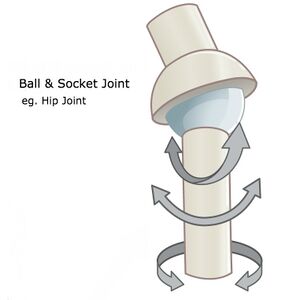⬤
Ball and Socket Joint: Difference between revisions
From WikiMSK
No edit summary |
|||
| Line 5: | Line 5: | ||
== List of {{PAGENAME}}s == | == List of {{PAGENAME}}s == | ||
{{Not ported}}{{#ask: | {{Not ported}}{{#ask: | ||
[[Has joint type::Ball and Socket Joint]] | [[Has joint secondary type::Ball and Socket Joint]] | ||
|?Has joint bones=Bones | |?Has joint bones=Bones | ||
|?Has joint ligaments=Ligaments | |?Has joint ligaments=Ligaments | ||
| Line 15: | Line 15: | ||
|mainlabel = [[Synovial Joint]] | |mainlabel = [[Synovial Joint]] | ||
}} | }} | ||
==References== | ==References== | ||
<references /> | <references /> | ||
[[Category:Joint Types]] | [[Category:Joint Types]] | ||
Revision as of 09:15, 2 April 2022
A ball and socket joint is an articulation between the rounded head of one bone (ball) and the concavity of another (socket). It is a type of synovial joint. This type of joint is multiaxial: it permits flexion/extension, abduction/adduction, and rotation. The only two ball and socket joints of the body are the hips and the shoulder (glenohumeral). The shallow socket of the glenoid cavity permits a more extensive range of motion in the shoulder; the deeper socket of the acetabulum and the supporting ligaments of the hip constrain the movement of the femur.[1]
List of Ball and Socket Joints
- This section is original unported content
| Synovial Joint | Bones | Ligaments | Muscles | Innervation | Vasculature | ROM | Volume |
|---|---|---|---|---|---|---|---|
| Glenohumeral Joint | Humerus Scapula | Capsule, glenohumeral, coracohumeral and transverse humeral ligaments | abduction: deltoid assisted by the supraspinatus; adduction: short scapular muscles (except supraspinatus) when the deltoid relaxes. Assisted by the pectoralis major and latissimus dorsi; flexion: clavicular head of the pectoralis major and the anterior fibres of the deltoid, assisted by the coracobrachialis and biceps; extension: latissimus dorsi, posterior fibres of the deltoid and the long head of the triceps; rotation: lateral rotation: infraspinatus and teres minor, medial rotation: subscapularis and teres major | suprascapular, subscapular, axillary and lateral pectoral nerves | anterior and posterior humeral circumflex, and subscapular arteries | arm flexion, extension, adduction, abduction, and internal and external rotation | |
| Hip Joint | Ilium Femur | Ischiofemoral, iliofemoral, pubofemoral, transverse acetabular, and ligamentum teres | 27 musculotendinous units are involved in hip function | Femoral, obturator and superior gluteal nerves, and nerve to quadratus femoris | Branches of the medial and lateral circumflex femoral, superior and inferior gluteal arteries and obturator arteries | Flexion 140°, extension 20°, Internal rotation 30°, external rotation 40°, abduction 50°, adduction 30° | 1-10mL |
References
- ↑ Juneja, Pallavi; Munjal, Akul; Hubbard, John B. (2022). "Anatomy, Joints". Treasure Island (FL): StatPearls Publishing. PMID 29939670. Cite journal requires
|journal=(help)


